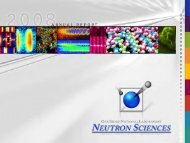An Introduction to Neutron Scattering - Spallation Neutron Source
An Introduction to Neutron Scattering - Spallation Neutron Source
An Introduction to Neutron Scattering - Spallation Neutron Source
Create successful ePaper yourself
Turn your PDF publications into a flip-book with our unique Google optimized e-Paper software.
A Comparison of Reac<strong>to</strong>rs & <strong>Spallation</strong> <strong>Source</strong>s<br />
Short Pulse <strong>Spallation</strong> <strong>Source</strong><br />
Energy deposited per useful neutron is<br />
~20 MeV<br />
<strong>Neutron</strong> spectrum is “slowing down”<br />
spectrum – preserves short pulses<br />
Constant, small δλ/λ at large neutron<br />
energy => excellent resolution<br />
especially at large Q and E<br />
Copious “hot” neutrons=> very good for<br />
measurements at large Q and E<br />
Low background between pulses =><br />
good signal <strong>to</strong> noise<br />
Single pulse experiments possible<br />
Reac<strong>to</strong>r<br />
Energy deposited per useful neutron is<br />
~ 180 MeV<br />
<strong>Neutron</strong> spectrum is Maxwellian<br />
Resolution can be more easily tailored<br />
<strong>to</strong> experimental requirements, except<br />
for hot neutrons where monochroma<strong>to</strong>r<br />
crystals and choppers are less effective<br />
Large flux of cold neutrons => very<br />
good for measuring large objects and<br />
slow dynamics<br />
Pulse rate for TOF can be optimized<br />
independently for different<br />
spectrometers<br />
<strong>Neutron</strong> polarization easier
















